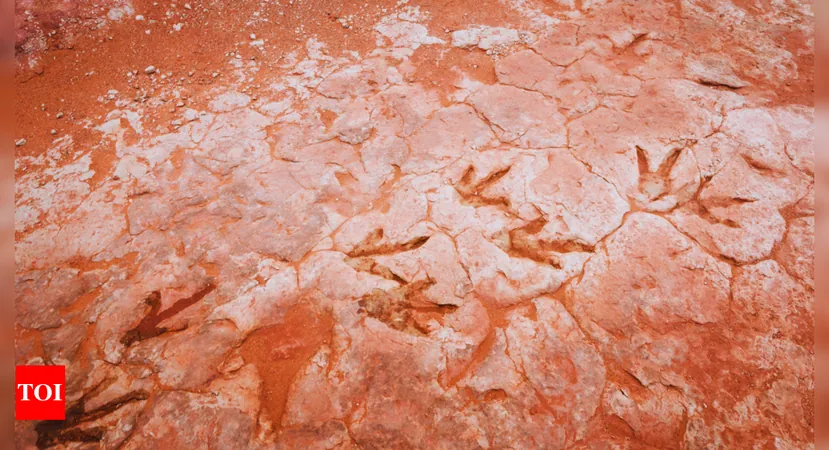
Dinosaur Highway: UK Unearths a 166-Million-Year-Old Dinosaur Footprint Treasure!
2025-01-08
Author: Sophie
Dinosaur Highway: UK Unearths a 166-Million-Year-Old Dinosaur Footprint Treasure!
In a groundbreaking discovery that has left paleontologists buzzing with excitement, more than 200 exceptionally preserved dinosaur footprints have been uncovered at Dewars Farm Quarry in Oxfordshire. This site is now recognized as the largest of its kind in the UK, offering a remarkable glimpse into the lives of dinosaurs during the Jurassic Period, which dates back over 166 million years.
A Peek Into the Jurassic Past
The footprints, which formed five distinct trackways, showcase the movements of two prominent dinosaur groups: the colossal herbivorous sauropods likely represented by the Cetiosaurus, a massive 18-meter-long creature, and the agile carnivorous Megalosaurus. Remarkably, the largest trackway stretches over 150 meters, comprising tracks that vividly depict these ancient giants as they traversed a lush landscape.
This discovery was initially brought to light by quarry worker Gary Johnson, who noticed unusual bumps in the ground while operating machinery. His keen observational skills, combined with expert collaboration from the University of Birmingham and Oxford, led to a meticulous week-long excavation in June 2024. During this effort, specialists employed advanced drone technology to create intricate 3D models of the footprints for future research.
Unlocking Secrets of Behavior and Movement
Fossilized footprints serve as more than just remnants of the past; they provide invaluable insights into the behavioral patterns of dinosaurs. Dr. Susannah Maidment from the Natural History Museum notes that while bones offer vital information about size and morphology, trackways unveil details about speed, herd behaviors, and walking patterns. The mud impressions in Oxfordshire's footprints capture the exact moment these magnificent creatures ambled across a tropical lagoon, providing an extraordinary perspective on their daily lives.
Researchers have meticulously documented over 20,000 images of the footprints, enabling them to analyze characteristics like size, gait, and social dynamics, painting a more comprehensive picture of how these prehistoric reptiles lived.
The Rich Jurassic Legacy of Oxfordshire
Historically, Oxfordshire was a vibrant, tropical environment filled with shallow seas and lagoons where various dinosaurs thrived alongside early mammals and flying reptiles such as pterosaurs. Importantly, this region is historically significant as it is where Megalosaurus—the first dinosaur ever scientifically described—was found back in 1824.
While many dinosaur bones from this region are fragmented, these newly discovered trackways present a more complete and dynamic view of life during the Jurassic era.
A Call to Preserve Our Prehistoric Heritage
This monumental find highlights the importance of conserving historical sites. Similar trackways at the adjacent Ardley Quarry were tragically lost when landfill was applied, erasing a part of our paleontological heritage. Experts are advocating for the preservation of this new site, wishing to make it accessible to the public for educational and scientific purposes.
This discovery not only enhances our understanding of Jurassic Britain but also deepens our appreciation for the fascinating creatures that roamed these lands millions of years ago. Could this be the key to unlocking more secrets of our prehistoric past? Stay tuned as researchers delve deeper into this monumental find!









 Brasil (PT)
Brasil (PT)
 Canada (EN)
Canada (EN)
 Chile (ES)
Chile (ES)
 Česko (CS)
Česko (CS)
 대한민국 (KO)
대한민국 (KO)
 España (ES)
España (ES)
 France (FR)
France (FR)
 Hong Kong (EN)
Hong Kong (EN)
 Italia (IT)
Italia (IT)
 日本 (JA)
日本 (JA)
 Magyarország (HU)
Magyarország (HU)
 Norge (NO)
Norge (NO)
 Polska (PL)
Polska (PL)
 Schweiz (DE)
Schweiz (DE)
 Singapore (EN)
Singapore (EN)
 Sverige (SV)
Sverige (SV)
 Suomi (FI)
Suomi (FI)
 Türkiye (TR)
Türkiye (TR)
 الإمارات العربية المتحدة (AR)
الإمارات العربية المتحدة (AR)